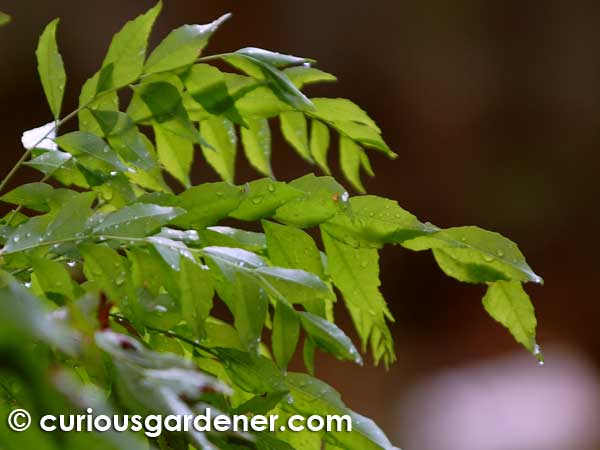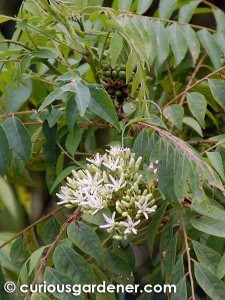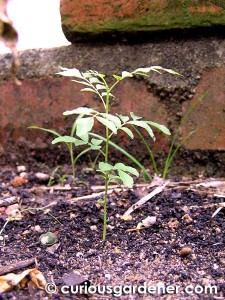Like many Singaporeans, we grow plants and trees that are used in seasoning Asian foods, and the curry leaf (Murraya koenigii) is one of the basic plants to have growing in your garden. It’s no longer used solely in Indian cooking – nowadays, with all the fusion cooking going on, it’s common to find a sprig of curry leaves seasoning the cuisines of other cultures.
What I love about curry leaves is the clean scent that they give off when you bruise or are cooking them.
The plant originates from India. It is known in different Indian dialects by different names: Kadhi Patta in Hindi, Mithho Limbo in Gujerati, Karuveppilai in Tamil and Malayalam, and so on. As names and words get skewed in different situations over time, we’ve been calling it Curry Pillay in our Singaporean household.
A friend recently taught me the Malayalam name, which means “Black Neem Leaf”. According to Wikipedia, “Karu/Kari” means black, “ilai” means leaves and “veppilai” means Neem leaf. Karuveppilai is a pretty complicated word to a non-Malayalam speaker, and I suspect we distilled the name down to “curry pillay” because that’s what we could remember. Besides, that’s what the leaves are used for – cooking curry – so it makes sense to me!
Our tree is an established one that’s close to 20 years old. It grows pretty straight and tall, with branches growing outwards and upwards from the main stem – or trunk, I should say. The bark is light-coloured, and relatively smooth and waxy. The tree gets full sun throughout the day and seems to enjoy it. It’s about 2 storeys high and doesn’t seem to want to grow taller. Instead, it spreads out via its branches that we prune a couple of times a year.
I’ve also discovered that it’s spreading itself via its roots – new plants are springing up from the roots of the old tree! I made this interesting discovery when I was trying to dig up a small plant to give away.
However, baby plants aren’t much of a problem if you bother to look. As mentioned in an earlier post, many fruit-eating bird are attracted to the curry tree because it produces bunches of berries. Black-naped Orioles, Asian Koels, Bulbuls and Mynahs are among the regular visitors to snack on the small berries. After eating, they find other perches and kindly spread the berry seeds all over the place. Because of this, we find little curry plants growing everywhere, and either give them away or weed them out. As a matter of fact, our tree has several “babies” across Singapore and one in Europe!
The curry leaf tree is perfectly suited to our tropical climate. We don’t do anything special to the tree – no need to water or fertilize it because Mother Nature does that for us, and the roots are deep enough to get through the dry periods. The only problem is that it attracts white pests, usually mealy bugs. Since I don’t want to spray insecticide on an edible plant, I usually cut off and dispose of the diseased branches. It would be great if more insect-eating creatures visited, though. Sunbirds and tailorbirds do drop by, but perhaps the mealy bugs aren’t to their liking. Life goes on.
© 2010 curiousgardener.com All rights reserved.




I have two young curry leaf trees, growing well about 18m ths old & 1 m high.They seem to have tiny white spots on the lower leaves. Can see no pests,is this just immature leaves ? The the trunks are slighly speckled too. Thanks F.
Hi Fiona,
Healthy leaves shouldn’t have any spots. In my experience, it’s probably caused by a pest, like mealy bugs, aphids or a passing insect that fancies your plant as a snack. Some of our leaves get attacked occasionally by something that leaves round spots & holes in the leaves. However, since we use the leaves in cooking, I don’t use any pesticides. Any diseased or affected parts of the plant are pruned and disposed of. The woody part of the trunk does have some black speckles – is that what you mean? If so then it’s normal. Cheers.
HI i just noticed that my curry leave plant has got white spots on the top of the leaves…. i’m sure they are not bugs or pest……its on the whole plant….what is it????? pls advice someone….